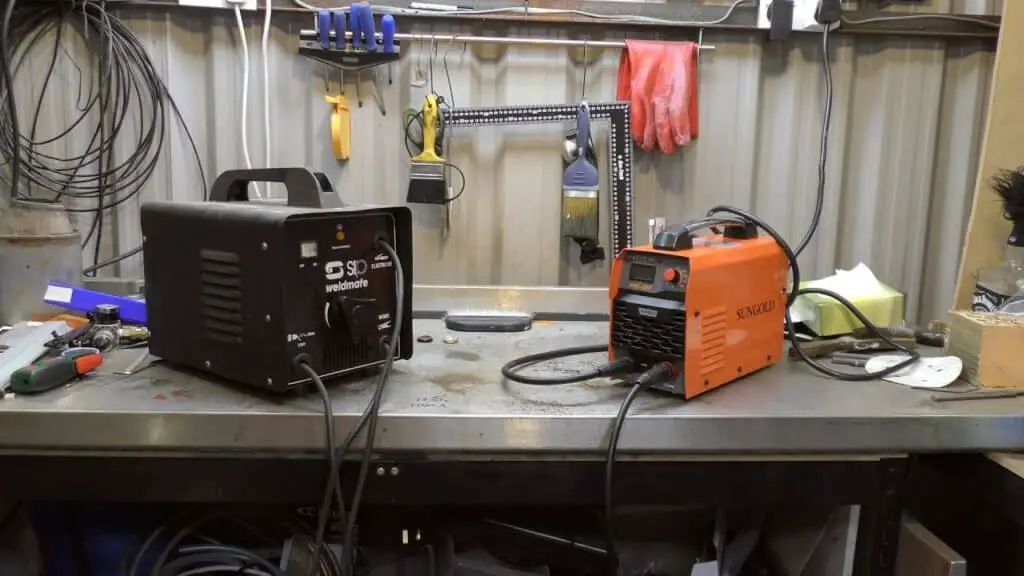Choosing between the two types of current AC or DC is a question that pops up quite often. When it comes to welders, the question becomes even more complicated. Well, fret not friends, I am here to help you with everything related to the topic. This blog will give you all the answers you need!

MIG DC welders are given preference in welding over MIG AC welders. The DC welders are quite capable of giving good results, without intervals in between the welds. However, certain situations demand MIG AC welders be used but this is quite rare.
Read further to see more about this…
Comparison Between AC and DC welding
AC and DC welding are two types of current that are used in welding. AC stands for Alternating Current and DC for Direct Current. While the former has variable polarity flow in terms of direction, the latter is constant on the same terms.
A comparison between the two can help you see how different both are:
| AC | DC | |
| Polarity | Alternating | Single |
| Metal | Thick | Thin |
| Stability of arc | Bad | Good |
| Control over the weld | Less | More |
| Versatility | Less | More |
| Penetration effect | Low | High |
| Weld quality | Satisfactory | Smoother than AC |
| Arc blow | No | Yes |
| Spatter | More | Less |
From the given table you can observe that there is a slight leaning of positives towards DC. The polarity of current can be either negative or positive.
This determines the flow of the current for AC while for DC the difference means nothing. And this is the primary reason why DC can provide the much-needed stability to the arc.
To have more about the two types check this link. https://www.physics.utoronto.ca/~jharlow/teaching/everyday06/reading16.pdf
MIG AC and DC welding machines
Well choosing a MIG welder is quite a dilemma if you are not sure about the type of current you need. I hope with the explanation given, you are now able to make out the major differences between the two types of current flow. So now let’s see about the MIG welders that fall under each category.
MIG DC welder
When it comes to welders the differences are not limited to the operational characteristics but goes on to include the physical aspects as well. MIG welder has the following pros and cons:
Pros:
1.) Good quality: Compared to MIG AC welders, DC welders are built of good quality materials and are most sturdy in nature.
2.) Versatility: MIG DC welders are capable of dealing with a gamut of metals. With the powerful welding nature of DC welders, it can easily go with the characteristics of different metals.
3.) Variety of electrodes: Just like metals, you can go for different electrodes with these. Compatibility issues are not a problem with these machines.
4.) Good power capability: Due to the quality of the built and constant current flow, the power capability of DC welders is much higher than its counterpart.
Cons:
1.) Complex nature: The basic reason for the stability that these machines provide is the complex nature and sophisticated setup these machines have. This complexity can also be a bane if you are not used to it. It takes time for a welder to get accustomed to the system.
2.) A bit pricey: The higher the quality, the higher will be the cost. When compared to AC MIG welders, these DC machines can give you a hard time with their prices.
3.) Not lightweight: With better settings comes a little weight. As the machines are supposed to serve almost all welding needs, they are made with parts that are to deal with various metals and their characteristics. Hence, these machines tend to be a tad bit heavier than AC MIG welders
4.) Takes up space: Due to their large size, they end up taking considerable space in your storage area.
5.) Not portable: Of course, with huge size and weight, these machines cannot accompany you in your welding ventures. They are quite cumbersome.
6.) Problematic arc: Arc blow is a major drawback of DC welding machines. Arc blow is a part of the DC and there is no way to avoid it. Distortion of the magnetic field is the reason for arc blow and with DC MIG welders, one needs to be pretty patient to deal with this issue.
MIG AC welder
MIG AC welders almost have the exact opposite characteristics of DC MIG welders. Let’s see their pros and cons.
Pros:
1.) Economical in nature: These welder machines are budget-friendly. With fewer specifications, they do not demand much from you, unlike MIG DC welders.
2.) Smaller in size: AC MIG welders are smaller in size when compared to DC MIG welders. These are quite compact and do not take up much space.
3.) Portable: As AC MIG welders are compact and lightweight, these machines can be easily carried from one place to another. This is one of the few factors why some prefer AC MIG welders over DC MIG welders.
4.) Needs low-upkeep: Yes, the welders do not demand much from you in terms of their upkeep. As the machines are quite simple in their working, the parts involved are not that prone to wear and tear.
5.) No arc blow: Magnetic distortion is not a part of AC welding and is therefore not a problem for the welders either. Not having the nuisance of arc blow is quite an attractive feature of AC MIG welders.
Cons:
1.) Can’t guarantee good results: AC MIG welders need the person welding to have constant control over the procedure. Stability is not a promise made by these welders and hence, getting a good finishing weld is not possible at all times. Results vary from one attempt to another.
2.) Not versatile: These welders are not compatible with a variety of metals, unlike MIG DC welders. The nature of current does not allow this to happen making these welders limited in terms of applications.
3.) Limited to a few electrodes: Not all electrodes are suitable for these machines for the same reason that was mentioned above.
4.) Weak power output: Power generation capability is lower for these welders. With the low built quality of the machine and double polarity of AC, power generation is not a good feature for MIG AC welders.
5.) Need an AC power supply: As these are AC welders, they specifically need an AC power supply to work. This becomes a problem as DC power supply is more common than AC. Meeting all your welding requirements with a single-purpose MIG AC welder is not possible.
Which is the most preferred welder among the two in MIG?
And here we are at the core part of the blog. So, now that you know about each type of welder and its features, it is time that we say the answer.
MIG DC welders are the most preferred and used welders among the two. In addition to the pros of these machines, certain other factors make people choose MIG DC welders over AC welders. They are:
1.) Best for a smooth weld: DC welding machines can guarantee smooth weld results with beads having a good profile and a spatter-free experience. One can rely on these machines for consistent results.
2.) Suitable for difficult positions: Apart from the pros that these machines have, MIG DC welders are excellent choices for welding in difficult positions. For overhead and vertical up welding MIG DC welders are the way to go.
3.) Constant polarity: AC welders work on a change in polarity- that is half DC negative and half DC positive. Many prefer to do a weld with a constant polarity throughout and hence MIG DC machines become easier to handle despite the complex nature.
For MIG AC machines, breaks in between are inevitable due to the polarity change. But with MIG DC welders, once you start you can complete the task in one go.
See also: Best Budget Gasless MIG Welder
Then, when does MIG AC welder become a necessity?
1.) When AC is the sole power supply: This is one of the obvious situations when MIG AC welders cannot be avoided. With only a particular power supply, the machine you use needs to be compatible with that.
But these are rare cases with certain low-quality welders (with only basic features). Today, such situations are avoided as people go for quality welders over low-priced entry-level machines.
2.) Unavoidable issues: Certain welds cannot be done aesthetically like the way the welder desires due to the arc blow of MIG DC welders. In such specific cases, usually, MIG AC welders become the only choice.
3.) Welding in corners: Shipbuilding is an industry where MIG AC welders are used prominently. The primary reason for this being the requirements of weld to be done in corner areas. With the need to avoid arc blow and proper welding of magnetized parts, AC welders become the obvious choice.
Should I stick to a single-purpose MIG welder?
Multipurpose welders are the ones that you can switch between AC and DC according to your welding needs. Even when these welders seem to be a convenient choice that can help you in various situations, multipurpose welders tend to be less effective than single-purpose welders.
The latter is developed to serve a particular need and is, therefore, more carved for the exact welding requirements that one goes for. For a strong weld that promises integrity, always choose single-purpose welders.
While for learning purposes, multipurpose welders are the right choice. To get a quick idea of the working of multipurpose welders, do check this link.
To wrap up
For reasons that we have mentioned in the blog, MIG DC welders have a slight edge over its counterpart. Yet choosing between AC or DC MIG welder will ultimately come to your welding goals. It is you who have to decide which is best for your welding ventures after a thorough study of the two types!
Hope this blog will help you with the same. Happy choosing!
I will be back with another interesting blog very soon!







